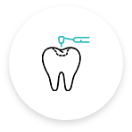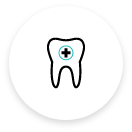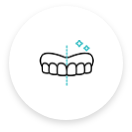Out of all the cosmetic dentistry treatments available today, dental bridges and dental crowns are the most popular. Affordable and versatile, crowns and bridges are easy to obtain through any dentist in your neighbourhood.
What are Dental Crowns and Tooth Bridges?
Crowns and most bridges are prosthetic devices that cannot be removed, like dentures. They are cemented onto your teeth or implants and can only be removed by a dentist.
Bridges and crowns are ideal for improving the appearance of your smile and restoring the dental function that may have been affected by a tooth loss, injury, or any other dental treatment done before.
Why do dentists recommend bridges and crowns?
Crowns and bridges are ideal for treating dental issues like missing teeth, decayed or broken and fractured teeth, chipped and cracked teeth, weak teeth, uneven teeth, and stained and discoloured teeth. They are also recommended to patients who have undergone root canal therapy to reinforce the tooth and protect it from potential reinfection.
If you are wondering whether or not you must go for dental bridges and crowns to restore your dental health and enhance your smile, try to understand these treatments well.
Dental Crowns
Crowns sit on a tooth, right from the bitting surface to the gum line. They are hollow caps that cover cracked, damaged, or discoloured teeth. Dental crowns support the entire tooth and restrict sugary substances, acids, and bacteria from penetrating it. If a patient has undergone root canal therapy, the dentist will likely suggest placing a crown on the tooth once it has healed completely.
Dental crowns can also be placed over healthy teeth around a missing tooth to hold the artificial tooth in place. They help replace missing teeth in the form of dental implants too. In such cases, a titanium post is implanted into your jaw, and once you’ve recovered from the surgery, a crown is fixed to that post with the help of an abutment to fill in the former gap in your jaw.
Dental Bridges
Dental bridges are dental prosthetics designed with a crown on each end that fits on a healthy tooth and an artificial tooth to fill in the gap created by missing teeth. (Dental bridges are also available with one crown, but they are less common than the traditional ones with two crowns.) The placement of a crown on the teeth to support a dental bridge requires removing some material from the natural teeth to ensure the crown fits snugly without bulking the underlying tooth. Once a dental bridge is fixed in its place, there will be no gap in your teeth, and the teeth surrounding the original gap will stay firm in their place without getting into the gap in your jaw.
Just like dental crowns, dental bridges are available in implant-supported options too. However, implant-supported bridges do not rely on the strength of any natural teeth and require no modification of any natural teeth to support the crown.
What To Expect During the Procedure?
What To Expect When Getting a Crown
Before the dentist starts the procedure, they will give you anaesthesia, so you don’t experience discomfort or pain. They will then extract the damaged pulp from the tooth and clean the cavity to prepare a healthy surface for fixing the crown. After this, dental impressions of your teeth will be taken to prepare a temporary crown that will be attached to the tooth.
Once your permanent crown is ready, your dental care provider will inform you and have a follow-up appointment. Next, your dentist permanently fixes the crown to your tooth using special dental cement. Once the crown bonds to the tooth, your dentist will examine if it matches the function and appearance of your natural teeth.
What To Expect When Getting a Bridge
Local anaesthesia will be provided when getting a dental bridge done as well. This will help avoid any pain or discomfort that you may experience otherwise. After performing the necessary root canals or extractions, your dentist will take impressions of your mouth to create a bridge that fits perfectly. Then, you will be given a temporary bridge to be worn until the permanent one is ready.
You will be called to fix your permanent bridge in a few weeks. The dentist will carry out the necessary modifications to the bridge to ensure you get the perfect fit.
Once you have your dental bridge or crown, you must clean them daily to ensure they last long. You may brush them using a small amount of toothpaste on your toothbrush to clean them. It is also recommended to floss between the teeth on your bridge to remove any food particles that may be stuck in between. Caring for dental bridges or crowns is as simple as caring for your other permanent teeth.
Both dental crowns and bridges help patients restore their confidence in their smile, which is a significant reason why they are popular amongst many. Technological advancements make dental bridges and crowns look as natural as your permanent teeth. To know more, about crown & bridges contact Hashtag Dentist expert.
Frequently Asked Questions
A crown or bridge is most commonly used to manage damaged or missing tooth problems. Apart from this, crowns and bridges can be used for many other situations. For example, your dentist may suggest you to go for crowns if you want to restore a fractured tooth, replace a large filling with too little tooth surface left, protect a weak tooth from cracking or breaking, cover a tooth that underwent a root canal, cover a dental implant or discoloured or poorly shaped tooth. On the other hand, a dental bridge may be recommended to solve missing teeth problems like bite issues, chewing difficulties, and pain that may erupt in jaws and teeth.
Dental crowns are placed on top of a tooth to strengthen, protect, or enhance its look. Crowns can be placed over an exposed area of a tooth to safeguard it from wear and tear from chewing. They are also an ideal option for a tooth with a root canal. The root canal leaves a gap in the tooth, usually filled with cement. Since this structure is weak, a dental crown on top can strengthen it. Moreover, dental crowns add a final touch to treatments like implants. It offers the impacted tooth both good looks and strength.
Which option of the two is better for you depends on your condition. Dental crowns are best for patients with a cracked or fractured tooth or those looking to cover an implant with a natural-looking option. Dental crowns are also a better option for replacing large fillings or strengthening a tooth that has undergone a root canal. However, a dental bridge will be a better option if a patient has lost more than one tooth in a row. If you aren’t sure which option is the best for you, speak to your dentist. They will examine your tooth or teeth and recommend the best treatment.
Dental crowns are highly beneficial for handling damaged or missing teeth. They offer the following benefits:
- They can save a highly damaged tooth
- They can save a dead tooth from falling apart
- They offer protection to a tooth with a decaying history
- They are an affordable cosmetic treatment
- If looked after well, they are permanent
If you have a tooth that requires restoration or touch-up, it is best to go for dental crowns. Treating your damaged or missing tooth issue with dental crowns can save you time, money, and discomfort.
A crown and bridge may last you for more than ten years with proper oral hygiene and care. It is normal for bridges and crowns to experience natural wear and tear from chewing and eating. However, with the appropriate cleaning and maintenance techniques, you can extend their life up to 10 years. Also, the lifespan of a bridge or crown depends on the material they are made of. For example, porcelain crowns will last longer than gold crowns because porcelain is a more robust material than metal composition. To ensure your bridges and crowns last longer, follow the after-care tips shared by your dentist.



























